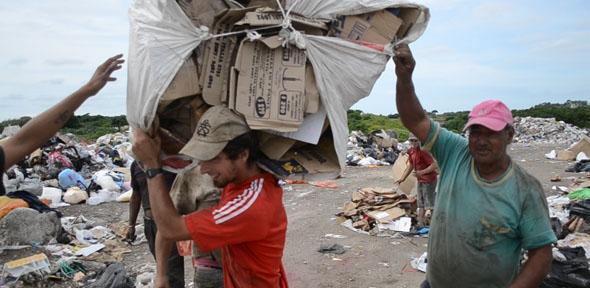
Returning to Uruguay’s largest landfill (cantera), ‘Felipe Cardoso’ in Montevideo, to conduct fieldwork for my PhD, I was delighted when local social worker and missionary Jorge told me that I could live at his home, in a housing cooperative overlooking the landfill.
I had worked as a labourer in the construction of the cooperative in 2010 and knew that most of the occupants were relocated residents of an infamous shantytown built on top of an old landfill.
I could use the house as a base for exploring Montevideo’s formal and informal waste trade, since many neighbours were urban recyclers, known locally as clasificadores or classifiers. I’d be able to accompany them as they left in the morning to recover value from the trash at sites nearby, often returning in the afternoon on motorbikes, trucks or horse-drawn carts laden with an impressive array of plastics, metals and cardboard, as well as food, clothing and electronics for domestic consumption or neighbourhood sale.
Waiting to move in and impatient to start fieldwork, I had eagerly accepted when one neighbour offered to host me temporarily in his yard. As it transpired, I lived for a week in the most densely populated accommodation I have ever experienced, sharing a shack with his teenage son and the flapping wings and loose bowels of 22 birds. Now, though, Jorge’s house would be my home for the following year. Initially a concrete block lacking windows and doors, I set about making it habitable, mostly using materials scavenged from the landfill.
Of course I could do nothing about the sights, sounds and smells of the landfill itself. It rose over the horizon, the third highest peak of low-lying Montevideo; the beeping of its reversing compacters could be heard throughout the night; and the strangely sweet smell of mixed urban rubbish drifted over in the morning mist.
Each day, some 60 trucks roll into the compound filled with urban rubbish. At the last count (in 2008, and likely to be an underestimate), around 5,000 waste-picking families make a living from Montevideo’s trash, attempting to recover all that is valuable, usable or edible. Their role in a city where waste management has reached crisis points in the past has been lauded as a lesson to society: they help to reduce the environmental and financial cost of landfill and find value in something that might be surplus to some but not others.

Like my interlocutors who recovered materials from there, I had ambivalent feelings about the cantera which, because of its reliable provision, was nicknamed “the mother”. On the one hand, it was an intriguing site for fieldwork where, under the supervision of Dr Sian Lazar, I focused on processes of labour formalisation, the socio-cultural dynamics of the waste and recycling work, and the history of waste infrastructure and aesthetics. On the other hand, it was also a place of hazard, police violence and a smell that lingered on clothes and skin, getting into hair and under fingernails.
I never slept at the dump but this was previously a common practice: clasificadores would camp there for days or weeks at a time, always at the mercy of the feared mounted police who would set tents alight, showing little tolerance for intruders.
The closest I came to the apparently boisterous atmosphere of these encampments was joining clasificadores of the Felipe Cardoso recycling cooperative as they spent the last nights in a building the municipality had ceded them for facilities but which some had appropriated as a residence. With the exception of veteran clasificador Coco, who lived there permanently, the space seemed to function as a temporary refuge for male clasificadores who had been kicked out by their wives! On the night of my visit, we sat and played cards, listened to cumbia music, drank into my supplies of Scotch, and discussed the impending closure of the site and the workers’ relocation to a formal sector recycling plant.
With the municipal government’s attempted formalisation of Montevideo’s recycling trade, it is possible that the days of such precarious, autonomous, clasificador spaces are numbered, to be replaced by hygienic and technologically provisioned infrastructures. Yet at the end of my research trip, many of my neighbours were still making their way to the cantera to classify the tons of waste dumped there daily.
Uruguayan priest Padre Cacho once described clasificadores as “ecological prophets” and I can see what he meant – they have long functioned as ‘prospectors’, mining the urban waste stream for valuable materials that consumers have been happy to discard, and municipal governments to landfill or incinerate.
Now back in Cambridge as an intern at the Centre for Science and Policy (CSaP), I am helping to organise a workshop on the ‘circular economy’ to explore the ways that government and industry are increasingly reconceptualising waste as recoverable resource. At a global level, it is important that shifts in policy benefit rather than dispossess informal sector recyclers, the long-time ‘artisanal miners’ of the waste stream.
Just before leaving Montevideo, the annual landfill clasificador Christmas social afforded me an enduring image of slumber amidst the scraps: an old, intoxicated and weary recycler lying on a recovered floral mattress, his sweated brow resting on a large folded rubbish bag, surrounded by thousands of pesos worth of scrap metal.
Patrick’s policy internship at CSaP is funded by the Economic and Social Research Council Cambridge Doctoral Training Centre.
In a new podcast, Patrick O’Hare describes his time with the clasificadores – the families who scavenge Montevideo’s pungent ‘wastescape’ to recover and classify anything that is valuable, usable or edible.

The text in this work is licensed under a Creative Commons Attribution 4.0 International License. For image use please see separate credits above.